Applications have been filed for the establishment of four new AVAs in the Willamette Valley of Oregon. Two of the proposed areas are the Tualatin Hills AVA and the Laurelwood District AVA. Applications for both of these areas highlight the loess soils that are abundant within the boundaries. While the Willamette Valley is noted for soils based on volcanic basalt (Jory) and marine sediments (Willakenzie), the loess-based soils known locally as Laurelwood have been mentioned as a less important type. Now, loess is getting headlines in these new AVA applications.
Vineyard soils are held in great esteem throughout the wine world. Growers tout the exemplary nature of the earth underpinning their vines – whether the basis be granite, limestone, basalt or other rock types. Loess soils, while they are not as often noted, are found throughout the agricultural world, comprising nearly ten percent of the earth’s soil surface. They are prized for their fertility and for the abundant crops they support. These widely distributed soils are of interest to winelovers because they underlie several famous winegrowing regions. We find references to loess and wine most commonly in Austria, Germany, Hungary and the western United States. On close inspection, we find that loess is more widely distributed in vineyards than we might have thought.
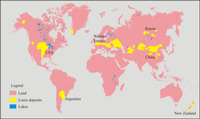
Worldwide Distribution of Loess
Loess (Löß in its native German) means “loose” – a reference to the poorly compacted nature of the soil. It is cultivated without difficulty and plant roots can grow with ease. In geologic terms, loess is a deposit of windblown silt. Silt particles are very small – about 100 times smaller than your average beach sand grain, so it’s easy to see how silt particles can be transported by strong winds. It’s also important to note that windblown sediments are naturally sorted by the wind speed. Heavier sand grains are left behind by winds that can only lift the much smaller silt particles destined to be loess.
Where does all the silt come from, one might ask. The answer for most of the world is a result of the vast glaciers that covered much of the land surface as recently as twenty thousand years ago – a blink of the eye in geologic time. The weight of glacial ice has the ability to crush the rocks beneath it. A quick calculation shows that a three-thousand-foot-thick glacier exerts a weight of 172,200 pounds for every square foot beneath it. As glaciers advance, they grind up the rocks beneath into a fine “rock flour”. When we look at lakes at the end of a glacier, we find the water is milky rather than clear. That is the visual evidence of this fine rock dust in suspension. This fine sediment is eventually carried downstream and deposited on riverbanks.
During periods when streamflows are low, the sediments dry out and can become airborne when strong winds arise. It is important to note that these are wind-borne deposits. Even in microscopic form, the silt particles collide in the turbulent winds and develop or maintain an angular form in the transportation process. Particles that are entirely transported by water often become rounded. Thus, when deposited, the airborne silt can become a cohesive soil while the water borne particles cannot. Think of trying to stack marbles as opposed to cubes and you can imagine the same forces at work in loess deposition.
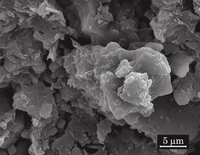
Angular Loess Particles Under High Magnification
The strong winds and cool, dry climate of the northern hemisphere as the glaciers retreated lifted vast clouds of dust and transported them to sheltered spots or dropped them as wind speeds abated. The combination of easy workability and an optimal balance of drainage and water retention make loess soils desirable for vines and many other crops. Loess is stable when it remains dry, but subject to severe erosion if it gets too wet. Terracing and other erosion control methods are often required to hold the loess in place.
The optimal conditions for deep loess deposition occurred during the glacial advances and retreats of the Pleistocene Period of the last two million years. The deepest loess deposits are in China, but those noteworthy to wine aficionados are in the central European winegrowing regions. The Tokaji-Hegyalja of eastern Hungary has long been noted for its luscious, botrytis affected dessert wines. The loess deposits here form the soils of the legendary Mézes Mály, Hétzőlő and Birsalmás vineyards, among others.
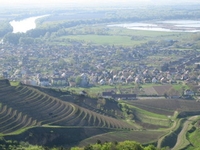
Terraced Vineyards in Loess Overlooking Tokaj
The deep loess soils along the Danube River in Austria provide a favorable environment for the Grüner Veltliner vines. Many sites in the Kamptal, Kremstal and especially the Wagram are noted for their deep loess soils. The Grüner Veltliner vines thrive in the deep soils and noted for powerful, rich styles. Many famous vineyards of the Kamptal – Lamm, Spiegel and Hasel – are planted on loess. Several producers highlight their terroir with designations such as “loess terrassen” or similar. There are deep deposits of loess in Kremstal and the Wachau as well. Producers often feel that wines from loess soils are fuller and softer in style than those from other soils – a characteristic popular with Grüner Veltliner fans.
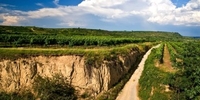
Deep Loess in Austria’s Kremstal Region
In Germany, loess deposits are found in the Nahe, Pfalz and Rheinhessen. Of particular note are the Oberhauser Brücke Vineyard in the Nahe, a monopole of the Hermann Dönnhoff estate, and the Krötenpfuhl and Brückes vineyards of Bad Kreuznach. In the Pfalz, sites with loess soils yield rich and flavorful Rieslings. The Ruppertsberger Reiterpfad and Gimmeldinger Mandelgarten vineyards are noted for loess soils and rich wines. The rolling hills of the Rheinhessen also have many vineyards on loess. Loess is widespread in the Hessische Bergstrasse and Baden, where the famous Kaiserstuhl vineyards are on loess overlying volcanic rock.
One of the most dramatic loess deposits in the world can be found in the Pacific Northwest. The vast wheat fields of the Palouse Hills in eastern Washington and Oregon are planted on loess. Not only is this fertile land abundant with grains, but these deep windblown deposits provide an excellent habitat for vines as well. The Columbia Valley AVA has many pockets of loess soils, but the most noted are in Walla Walla, where the windblown covering can be quite thick. Leonetti’s Loess Vineyard pays homage to its soil. The Seven Hills and Les Collines vineyards are noted for loess soils.
As we noted at the start, Loess is common in Oregon as well. If the new AVAs are established, the distinction of loess soils will become even better known. The Jacob Hart Vineyard of Rex Hill is on Laurelwood loess soils as is Adelsheim’s Nicholas Vineyard in the Chehalem Mountains. Elk Cove’s Windhill and Five Mountain Vineyards are also planted in Laurelwood loess. There are many more sites that will achieve greater fame as growers seek to get more from loess.
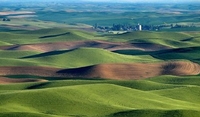
Deep Loess Covers the Palouse Hills of Eastern Washington
There is loess outside of the west coast wine country. In the central US, wineries are taking advantage of the deep loess soils on the east bank of the Missouri River in Iowa and Missouri. There is even a Western Iowa Wine Route that winds through the newly-established Loess Hills District AVA that Iowa shares with Missouri. Missouri vintners are planting Norton grapes on the deep loess soils overlooking the Missouri River. Knowing the stories behind the wines we love is part of the joy of wine. It’s a fun exploration to enjoy wines from divergent areas with similar soils.
